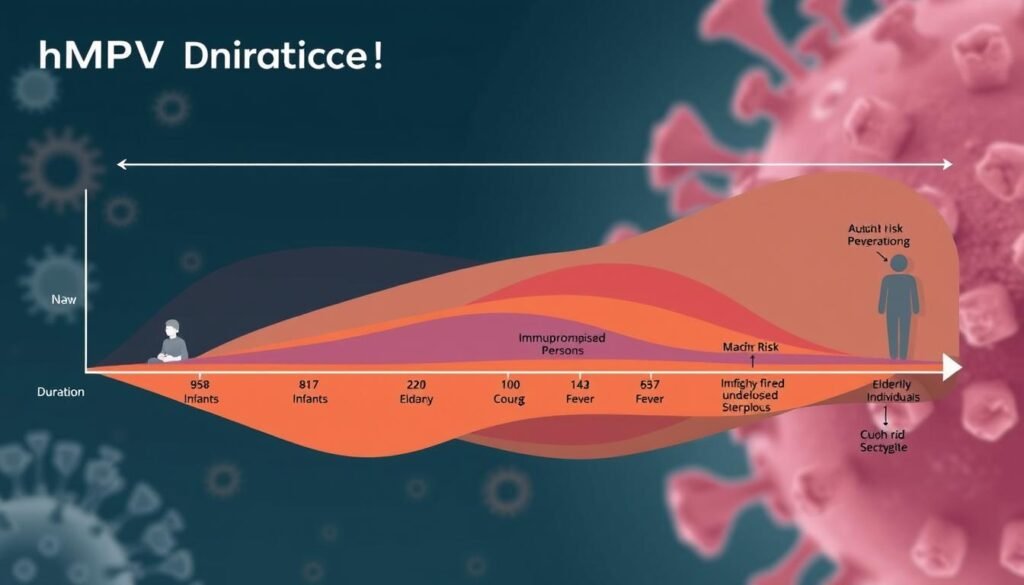When we or our loved ones get a viral infection like Human Metapneumovirus (hMPV), we wonder how long it lasts. The time it takes to recover from hMPV can differ, but usually, it’s a few days to a week.
Knowing how long hMPV lasts and how to recover is key. The time it takes to get better can depend on many things. These include your immune system, age, and health. We’ll look at symptoms, how it spreads, treatments, and recovery. We’ll also talk about what can affect how long it lasts.
We aim to give a full guide on hMPV’s timeline and recovery. This includes how long it lasts and how to recover. Whether you’re worried about your child or want to know more about hMPV, this article is for you. It will help you understand hMPV and its effects, including recovery time.
Table of Contents
ToggleKey Takeaways
- hMPV is a viral respiratory infection that can cause mild to severe symptoms.
- The duration of hMPV can vary from person to person, but most people recover within a few days to a week, which is the typical hmpv recovery time.
- Understanding the timeline and recovery process of hMPV is important for managing the infection effectively, including knowing how long does hmpv last.
- The hmpv duration and hmpv recovery time can be influenced by various factors, including the individual’s immune system, age, and overall health.
- Individuals with weakened immune systems, asthma, or respiratory conditions are at higher risk for developing serious illnesses, such as bronchitis or pneumonia, which can affect the hmpv recovery time.
- Recovery from hMPV infection typically occurs within 7 to 10 days for most individuals, which is an important aspect of the hmpv duration and hmpv recovery time.
Understanding Human Metapneumovirus (hMPV)
Human metapneumovirus (hMPV) is a common virus that causes cold-like symptoms. It usually lasts for several days. It affects people of all ages, but mostly young children and older adults.
Recent data shows hMPV cases rise in colder months. This is when people spend more time indoors.
We will explore how hMPV impacts the respiratory system and who is at risk. Knowing the hmpv contagious period helps understand how it spreads. hMPV mainly circulates in late winter and spring, like seasonal flu and RSV.
What is hMPV?
hMPV was first found in 2001 and has been around for decades. It often causes upper respiratory infections in kids under 5. At-risk groups include infants, older adults, and those with health issues like immunosuppression and asthma.
How hMPV Affects the Respiratory System
hMPV infections can be mild or severe, depending on one’s health. Symptoms are similar to the common cold or flu. In vulnerable groups, it can lead to pneumonia and bronchitis.
The hmpv treatment duration usually involves over-the-counter medicines. Most people get better in a few days.
How Long Does hMPV Last? Typical Duration and Phases
The time it takes for hMPV to go away can differ for everyone. Most people get better in a few days to a week. Knowing when you can stop worrying about spreading the virus is key.
Symptoms of hMPV usually last from 2 to 7 days. But, some people might take longer to feel better. How long you have hMPV can depend on your age, health, and treatment.
hMPV spreads mainly through close contact and touching things with the virus on them. Knowing when you can stop worrying about spreading the virus is important. This helps prevent others from getting sick.
In short, knowing how long hMPV lasts is important. It helps you manage the infection and stop it from spreading. By understanding when you can stop worrying about spreading the virus, you can protect yourself and others.
Initial Symptoms and Early Stage Timeline
When we first get human metapneumovirus (hMPV), it feels like a mild cold. We might cough, sneeze, and have a runny nose. It’s important to see a doctor if these symptoms get worse or last too long. Knowing how long hMPV lasts helps us manage it better.
The time hMPV symptoms last can vary. Usually, they stick around for 1-2 weeks. Watching how your symptoms change is key. If they get worse or last too long, you should see a doctor. Your age and health can affect how long hMPV lasts.
It’s important to get medical help if your symptoms don’t get better or get worse. This is true for people at high risk, like young kids, older adults, and those with weak immune systems. Knowing how long hMPV lasts helps us take care of ourselves and get help when we need it.
| Symptom | Duration |
|---|---|
| Coughing | 1-2 weeks |
| Fever | 3-5 days |
| Nasal congestion | 1-2 weeks |
| Sore throat | 3-5 days |
Peak Infection Period and Severity
The peak infection period of hMPV can happen a few days after getting sick. The severity of symptoms varies among people. Knowing the hmpv symptoms timeline helps manage and treat the illness effectively. During this time, people might feel very sick, with fever, cough, and trouble breathing.
Studies show the hmpv treatment timeline depends on how severe the infection is. Most people get better with supportive care. But, those who get very sick might need to stay in the hospital and be watched closely.
It’s important to remember that hMPV can spread before symptoms show up and up to 2 weeks after they go away. This is longer for some groups, like young kids, older adults, and those with weak immune systems.
- Age: Children under the age of five and elderly adults are more susceptible to severe symptoms.
- Underlying health conditions: Individuals with chronic pulmonary, neural, or heart disorders are at higher risk of severe infections.
- Immune system: Weakened immune systems can increase the risk of severe symptoms and longer contagious periods.
| Factor | Effect on Severity |
|---|---|
| Age | Increases severity in children under 5 and elderly adults |
| Underlying health conditions | Increases risk of severe infections |
| Immune system | Increases risk of severe symptoms and longer contagious periods |
Transmission and Contagious Period
Human metapneumovirus (hMPV) spreads through close contact, like touching or sharing utensils. Knowing the hmpv contagious period is key to stopping its spread. Studies show the hmpv shedding time can change, but we must act to stop it.
To stop hMPV, good hygiene is vital. Wash hands with soap and water for 20 seconds often. Also, clean surfaces that many touch to lower virus spread. Here are some ways to stop it:
- Wash hands frequently with liquid soap and water
- Disinfect frequently touched surfaces
- Avoid close contact with people who are infected
Understanding the hmpv contagious period and taking precautions can help. Knowing the hmpv shedding time is important. We must act, mainly in groups at risk like kids, the elderly, and those with weak immune systems.
Recovery Timeline and Process
The time it takes to recover from hmpv varies. Most people get better in a few days to a week. The hmpv prognosis is usually good, with most people fully recovering without lasting effects.
Several factors can influence how long it takes to recover. These include age, health, and treatment. For example, older adults and young children might take longer to get better because their immune systems are weaker. People with health issues like asthma or COPD might also face a longer and more complicated recovery.
If symptoms get worse or last longer than expected, it’s important to see a doctor. A healthcare professional can guide you on the best treatment and help avoid complications. Sometimes, hospital care is needed to ensure proper monitoring and care.

The hmpv recovery period can be broken down into several stages. These include:
- Mild symptoms, such as cough and fever, which usually last 2-5 days
- A recovery phase where symptoms lessen but may not go away completely
- A final stage where the person fully recovers and returns to normal activities
Knowing about the hmpv prognosis and recovery timeline helps individuals and their families prepare. It also helps them take steps to prevent complications.
Treatment Options and Duration
When treating hMPV, the main goal is to manage symptoms and help the body heal naturally. The hmpv treatment duration can change based on how severe the infection is and the person’s health. Symptoms usually last 7-10 days, but can go up to two weeks in some cases.
Doctors might give medicine to help with fever and cough. Remember, antibiotics don’t work on hMPV because it’s a virus. But, they might be used if a bacterial infection happens after. Rest, drinking lots of water, and using a humidifier can also help feel better and recover faster.
Expected Treatment Timeline
The hmpv symptoms timeline has different stages. At first, symptoms might be mild and last 3-5 days. As the infection gets worse, symptoms can get more serious, including breathing problems. Most people get better from hMPV in 7-10 days without any big issues.
If symptoms get worse or if you have trouble breathing, chest pain, or a really bad headache, see a doctor right away. Knowing about the hmpv treatment duration and hmpv symptoms timeline helps manage symptoms and support recovery.
| Stage | Duration | Symptoms |
|---|---|---|
| Initial | 3-5 days | Mild symptoms, such as runny nose and cough |
| Progression | 5-7 days | Worsening symptoms, such as fever and difficulty breathing |
| Recovery | 7-10 days | Improving symptoms, such as reduced fever and cough |
Special Considerations for High-Risk Groups
Some groups face a higher risk of severe illness from hMPV. These include children, the elderly, and those with weakened immune systems. The hmpv infection duration can differ based on health and infection severity.
High-risk groups must take extra steps to prevent hMPV spread. This means washing hands often, practicing good respiratory etiquette, and staying away from sick people. The hmpv recovery period is often longer for these groups, and they might need more medical care.
Some important statistics to note are:
- Children under 2 are at a higher risk for severe hMPV, with a rate about twice that of kids aged 2 to 5.
- The elderly, and those with health issues, often see hMPV infections come back, mainly in those over 65.
- People with weakened immune systems, like those on chemotherapy or with HIV/AIDS, are at a higher risk of severe hMPV infections.

By knowing the risks and taking precautions, we can lower hMPV spread. This helps ensure a smoother hmpv recovery period for those infected.
| Group | Risk Level | Precautions |
|---|---|---|
| Children under 2 | High | Frequent handwashing, respiratory etiquette |
| Elderly patients | High | Avoid close contact with infected individuals, practice good hygiene |
| Immunocompromised individuals | High | Take extra precautions to avoid infection, such as wearing a mask in public |
Long-term Effects and Complications
We often focus on the immediate symptoms and treatment of hMPV. But, it’s key to think about the long-term effects and complications. The hmpv prognosis can change based on the person and how severe the infection is. In some cases, hMPV can cause long-lasting respiratory problems, like asthma, and other issues.
The hmpv infection duration also plays a role in long-term effects. The longer the infection lasts, the more likely complications are. It’s important to see a doctor if symptoms don’t get better or get worse. Some possible long-term effects and complications of hMPV include:
- Respiratory problems, such as asthma or chronic obstructive pulmonary disease (COPD)
- Secondary bacterial infections, which can lead to complications like pneumonia
- Exacerbation of existing respiratory conditions
Knowing about these long-term effects and complications is key to preventing and managing them. By understanding the hmpv prognosis and hmpv infection duration, people can take steps to protect their health and well-being.
| Complication | Description |
|---|---|
| Respiratory problems | Conditions such as asthma or COPD that can develop or worsen due to hMPV |
| Secondary bacterial infections | Infections that can occur in addition to hMPV, leading to complications like pneumonia |
Prevention Strategies and Immune Support
Studies show that good hygiene, like washing hands for 20 seconds, is vital. Wearing masks and keeping a safe distance in crowded places also helps. Staying home when sick and avoiding those who are sick stops the virus from spreading.

- Washing hands frequently with soap and water
- Wearing masks in crowded spaces
- Staying home when symptomatic
- Avoiding close contact with infected individuals
- Practicing good hygiene and cleanliness
By using these prevention methods and boosting our immune systems, we can fight off hMPV. Remember, hmpv shedding time differs for everyone. So, it’s important to stay vigilant and protect ourselves and our communities.
Conclusion: Managing hMPV Effectively
Managing human metapneumovirus (hMPV) well needs a full plan. Healthy people usually get better in 1-2 weeks. But, how long it takes can change a lot. It depends on age, health, and quick treatment.
It’s very important to see a doctor if symptoms don’t go away or get worse. This is true for people at high risk like babies, the elderly, and those with weak immune systems.
Stopping hMPV before it starts is the best way to fight it. Washing hands often, using alcohol-based sanitizers, and staying away from sick people can help. Even though there’s no vaccine yet, scientists are working hard to find one.
Knowing how hMPV works helps us get ready for it. We can stay safe by washing our hands, keeping clean, and getting help when we need it. This is how we can handle hMPV well.
FAQ
What is hMPV?
hMPV, or human metapneumovirus, is a respiratory virus. It causes colds, bronchitis, and pneumonia. It affects people of all ages but is severe in young children, the elderly, and those with weak immune systems.
How does hMPV affect the respiratory system?
hMPV infects the upper and lower respiratory tract. It causes inflammation and irritation. Symptoms include coughing, sneezing, and a runny nose. In severe cases, it can cause bronchiolitis or pneumonia, making breathing hard.
What are the common risk factors for hMPV infection?
Risk factors for hMPV include age and health conditions. Young children, the elderly, and those with asthma or chronic lung disease are at higher risk. A weakened immune system also increases the risk.
How long does hMPV typically last?
hMPV usually lasts 1 to 2 weeks. The incubation period is 4 to 6 days. Symptoms peak around day 5 to 7. Recovery takes an additional 7 to 10 days.
What are the first signs of hMPV infection?
The first signs are a runny nose, cough, and sore throat. These symptoms appear 4 to 6 days after exposure. If symptoms worsen or last longer, seek medical help.
How severe can hMPV symptoms become?
Symptoms can be severe, mainly in high-risk groups. Young children, the elderly, and those with weak immune systems are at risk. During the peak, symptoms like high fever and difficulty breathing can occur.
How long is the hMPV contagious period?
The contagious period is up to 10 days after symptoms start. The virus spreads through respiratory droplets and touching contaminated surfaces. Good hygiene and avoiding close contact are key to prevent spread.
What is the typical recovery timeline for hMPV?
Recovery time varies based on age, health, and infection severity. Most people start feeling better in 7 to 10 days. Full recovery can take up to 2 weeks. Seek medical help if symptoms worsen or last too long.
What are the treatment options for hMPV?
Treatment focuses on managing symptoms and supporting healing. Over-the-counter medications help with cough, fever, and congestion. Rest and hydration are also important. In severe cases, antiviral medications or other interventions may be recommended.
Are there any special considerations for high-risk groups with hMPV?
Yes, certain groups face a higher risk of severe infections. Young children, the elderly, and those with weak immune systems need closer monitoring and treatment. Vaccination or prophylactic medications may be recommended.
Can hMPV lead to long-term effects or complications?
Most hMPV infections resolve without long-term effects. But, it can lead to severe complications in some, like chronic respiratory issues. Monitor for ongoing symptoms and seek medical help if necessary.



Pingback: How Many Cases Of HMPV Are There In India? Get The Facts On.
Pingback: How Can I Sleep 8.5 Hours?
Pingback: How Do You Calm Your Mind From Overthinking Quotes? Expert-B